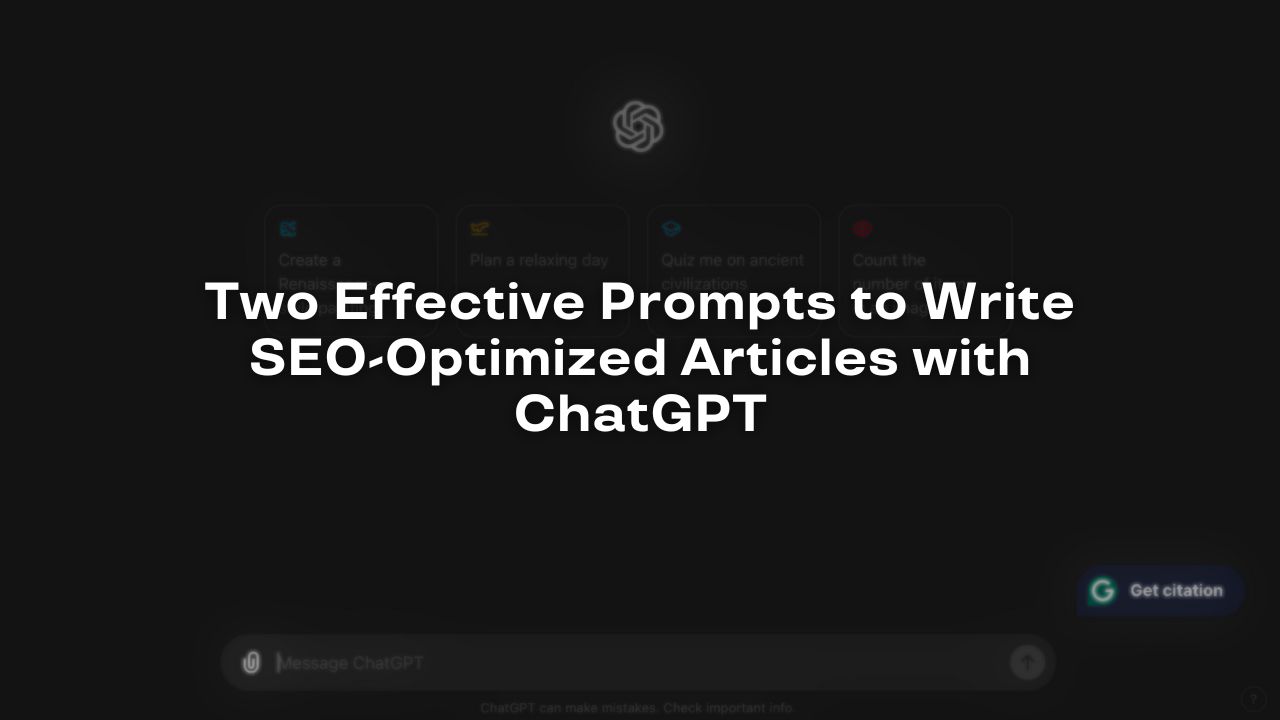Struggling with blog writing? ChatGPT can help streamline your content creation process. From generating detailed outlines to writing articles section by section, AI tools like ChatGPT can simplify and accelerate your workflow. In this post, we will cover two effective prompts for writing articles with ChatGPT that will help you create well-structured, SEO-optimized blog posts effortlessly. Whether you’re a content writer or a business owner managing your own blog, these prompts are designed to guide you step by step.
Note from the author: The two prompts for content writing that we’re going to talk about are the result of my 2 years of research with prompt engineering in content writing. Thank me later!
Why Use ChatGPT for Blog Writing?
In the digital marketing world, creating SEO-friendly blog content is crucial for boosting website traffic and search engine rankings. AI-powered writing tools, like ChatGPT, can help you optimize your blog for relevant keywords while maintaining high-quality content. In the below sections, I’m going to share the best ChatGPT prompts for blog writing that I, personally developed and tested for over a year. With these prompts, you can ensure that your blog posts are well-organized, informative, and tailored to your audience.
Read more on why ChatGPT is a boon for content writers and how to use ChatGPT for content writing.
First Prompt: Crafting a Detailed Blog Outline with ChatGPT
The first step to writing a high-quality blog is having a clear structure. ChatGPT can generate a detailed blog outline based on the guidelines you provide. This makes it easier to stay on topic and cover all important aspects.
Prompt:
First Prompt for Blog Writing
I want to write an article on [BLOG TOPIC]. I need you to create a detailed outline for the article. here are the outline guidelines:
* I’m uploading three web pages that you can refer to in order to suggest a detailed outline for the article. Try to use all these web pages for different sections with an aim to include the best information possible.
* Make sure to use information only from the reference web pages I’m uploading. Also, retain all the information gathered from the reference web pages I’m uploading and use that while writing for the blog post.
* Include the following in the intro: A couple of statistics from the text I’ll be sharing later, one or two liner statements discussing each and relation between them. Then, subtly blend the first H2 in.
* Include the following headers in the blog: [Add the H2 you want to include in the article.]
* Use statistics throughout the article. Use statistics related to AI from the text below throughout the outline wherever they’re relevant:
How it helps:
This prompt allows ChatGPT to create an outline that includes SEO-friendly sections relevant to your topic. Using a well-organized structure ensures that your article ranks higher in search engines by targeting key terms such as “AI-powered recommendation systems” or “types of AI systems.”
Second Prompt: Writing Blog Posts One Section at a Time with ChatGPT
Once you have a clear outline, the next step is to start writing. This second prompt ensures that you write the article in manageable sections using ChatGPT. This method guarantees that you maintain control over the content and tailor each part to meet your SEO needs.
Second Prompt for Blog Writing:
Great. Now, let’s start writing. Use information from the reference webpages I’ve shared earlier. write one section at a time. I need you to include all the information from the webpages I’ve shared. also, use simpler language as used in the reference webpages and be straightforward while writing. don’t use unnecessary paragraphs and phrases. make sure that you vary the writing style throughout the article so that it appears to be written by a human being. “Make sure to write one section at a time and then confirm it with me. Once confirmed, you can move forward to the next section.”
How it helps:
This step-by-step approach allows you to create SEO-friendly blog content that is concise and well-structured. It ensures that each section of your article targets specific keywords and addresses relevant subtopics, which improves your content’s relevance and search engine ranking.
Also Read: AI Writing Tools for Content Writers
Additional Tips for SEO-Friendly Blog Writing with ChatGPT
- Optimize for Keywords:
When using ChatGPT to write blog posts, ensure that you provide it with the most relevant keywords for your topic. This will help you generate SEO-friendly headings, subheadings, and content that aligns with search engine optimization (SEO) best practices. - Use Relevant Meta Descriptions:
Meta descriptions play a key role in improving your blog’s visibility. Ask ChatGPT to generate concise and relevant meta descriptions for each blog post to further enhance SEO. - Incorporate Internal and External Links:
Use internal links to other pages on your website and external links to high-authority sources. This improves user experience and helps boost your website’s authority in search engine rankings. - Include LSI Keywords:
When writing articles with ChatGPT, don’t forget to include Latent Semantic Indexing (LSI) keywords. These are terms related to your main keyword that help search engines understand your content better. For example, if you’re writing about “AI-powered recommendation systems,” include terms like “machine learning in eCommerce,” “personalization with AI,” or “AI in digital marketing.”
Maximizing SEO Benefits with ChatGPT: Best Practices
- Use Clear Headings and Subheadings:
When creating your outline, ask ChatGPT to suggest SEO-friendly headers and subheaders. Headers like “How to Write Blog Posts with AI” or “Step-by-Step Guide to AI Blog Writing” can improve SEO while making your content easy to navigate. - Focus on Readability:
Google values readability and user experience. Make sure your ChatGPT-generated content uses simple, concise language, and short paragraphs. Tools like Hemingway App or Grammarly can help enhance readability. - Content-Length and Keyword Density:
Longer, in-depth blog posts tend to rank higher in search results. However, make sure you maintain an appropriate keyword density (1-2%) throughout the post to avoid keyword stuffing. Ask ChatGPT to maintain this balance while generating the article.
Conclusion: How ChatGPT Can Revolutionize Your Blog Writing Process
With these two prompts, anyone can harness the power of AI writing tools like ChatGPT to generate well-structured and SEO-friendly blog posts. The first prompt helps you create an outline using detailed references, while the second allows you to write the blog post section by section. This approach ensures high-quality content, better keyword optimization, and higher search engine rankings.
Whether you’re a content marketer, small business owner, or freelance writer, these ChatGPT prompts will simplify the blog writing process and improve your SEO performance. Try these out for your next blog post and see how AI can enhance your content strategy!

I’m a marketer turned into a content writer. I go the unconventional paths of content writing to explore the horizon of possibilities and novel approaches to help brands communicate.
If you’ve loved reading this blog, hit me a ‘Hi’ on LinkedIn.
